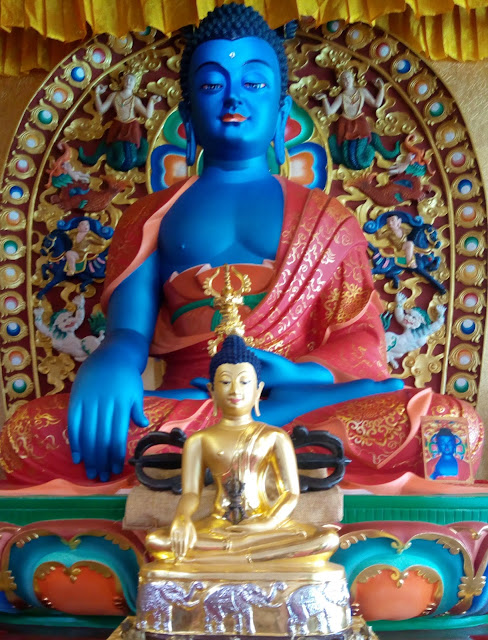The "Immovable One" - Akshobhya Buddha 阿閦如来
I would like to share with all something of Akshobhya Buddha.
Yesterday, I attended an Akshobhya Buddha Puja at one of the local Tibetan Buddhist center.
This was one of my very first and rare opportunity to be part of the activity.
I am exceptionally blessed to be in the presence of the sacred Holy shrine of Akshobhya Buddha.
Akshobhya Buddha is one of the five Dhyani Buddhas (wisdom Buddhas), along with Vairocana, Amitabha, Ratnasambhava, and Amoghasiddhi.
Akshobhya is usually depicted in blue color, symbolizing the color of clear water that reflects things as they are. Akshobhya symbolizes a clear mirror-like wisdom, which can transform any anger and clean stiff feelings.
No reflection in a mirror sticks to it, and none repels it. The mirror always stands imperturbable and immutable, just as we should, whether the circumstances are favorable or unfavorable to us.
Akshobhya is doing earth-touching gesture (Bhumisparsha mudra) with the fingertips of his right hand. This gesture suggests confidence, deep-rootedness and determination. In his left he holds Dorje on his lap. Buddha Akshobhya may be together with his consort Lochana and usually is accompanied by two elephants.
As an elephant places its foot upon the earth with unshakeable certainty, so the Buddha Akshobhya mind reflects everything. Akshobhya Buddha symbolizes the overcoming of passions such as anger and hatred towards other beings.
The Akshobhya Buddha originates from the blue mantra "Hum" and when he became a Buddha and reached enlightenment, his Buddha field is the Eastern paradise of Abhirati.
In Sanskrit, Eastern paradise of Abhirati , literally means the Buddha fields of the most blissful. It is believed that those who are reborn in this realm can never fall back to lower realms of consciousness and are never to be born again.
The Buddha Akshobhya mantra is considered an effective remedy for purifying ones negative karma and thus is very beneficial even for non-Vajrayana practitioners.
Thank you for reading, may you find peace and great bliss. With your support it helps to spread the Buddha’s precious teachings and turning the Dharma wheels in the world.
Aspiration For Bodhichitta
For those in whom the precious Bodhichitta has not arisen
May it arise and not decrease
But increase further and further.
Dedication of Merit
By this merit may we obtain omniscience then.
Having defeated the enemies wrong-doings.
May we liberate migratory from the ocean of existence.
With its stormy waves of birth, old age, sickness and death.
*Note
I do not own or infringe any copyright of the picture(s).
Picture(s) courtesy and credit to the rightful distributors and or studios.
Picture(s) is/are intended for editorial use only.





























